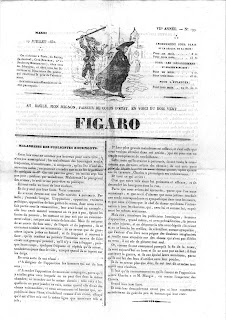The satirical journal Figaro played a fraught but defining
role in the history of the Bouzingo group--indeed, they were given that
name in the articles contained in the archive copies of Figaro.
Founded in 1826, the journal had helped to lay the groundwork for
oppositional satire in France and was closely tied to Romanticism.
However, its editor, Henri de Latouche, opposed the excesses of the
nascent Romanticist avant-garde, attacking the Petit-Cénacle /
Jeunes-France group with a series of outrageous humurous stories in the winter of 1831,
in which the group's extreme public persona (Gothic, Revolutionary, Blasphemous, Rowdy) was pushed to extreme
limits. This seems to be
the first time that the name 'Jeune-France' was applied to the group in
print, and may have been the genesis of the name, though they
deliberately misspelled it when claiming it for their own. They adopted the wild legends with glee in their internal mythology, public personas, and self-referential poems and stories.
Latouche was attacked in turn by Petrus Borel in his Preface to Rapsodies, but had already, in January 1832, beens replaced as editor, and The Figaro became a right-wing legitimist organ overnight. Searching for a satirical symbol for the political & cultural radicalism they now wished to attack, they settled on the Jeunes-France, several of whom had been arrested in the street in the middle of the night the previous year, singing a song which declared that they "were doing" or "making the bouzingo". The Figaro thus created a stock-caricature of the mad, godless, rabidly anti-government "Bousingot" and published another series of comic stories, accentuating the group's political radicalism and mapping the resulting stereotype onto a larger segment of radicalized youth culture. Again, the group (temporarily) adopted this term of intended abuse; their attempt to publish a group anthology of Tales of the Bouzingo never came about, but several stories about avant-garde life--themselves satirizing the Figaro's satires--were published in 1833. The issues collected here contain many of those "Bousingot" satires, alongside others of Saint-Simonist socialism, with which the group critically engaged.
Latouche was attacked in turn by Petrus Borel in his Preface to Rapsodies, but had already, in January 1832, beens replaced as editor, and The Figaro became a right-wing legitimist organ overnight. Searching for a satirical symbol for the political & cultural radicalism they now wished to attack, they settled on the Jeunes-France, several of whom had been arrested in the street in the middle of the night the previous year, singing a song which declared that they "were doing" or "making the bouzingo". The Figaro thus created a stock-caricature of the mad, godless, rabidly anti-government "Bousingot" and published another series of comic stories, accentuating the group's political radicalism and mapping the resulting stereotype onto a larger segment of radicalized youth culture. Again, the group (temporarily) adopted this term of intended abuse; their attempt to publish a group anthology of Tales of the Bouzingo never came about, but several stories about avant-garde life--themselves satirizing the Figaro's satires--were published in 1833. The issues collected here contain many of those "Bousingot" satires, alongside others of Saint-Simonist socialism, with which the group critically engaged.
~~~~~~~~~~~~~~~~~~~~~~~~~~~~~~~~~~~~~~~~~~~~~~
Figaro. Year 7, No. 40 (Feb. 9, 1832). Sole Edition: Paris. Paperback Quarto, 4 pp. (online HERE)
This issue contains a parody 'Manifesto' of the Bouzingo, entitled
simply,"Le Bousingot," and an article arguing against the "fantastique"
or frenetic genre (associated with the nascent avant-garde) as
anti-French.
~~~~~~~~~~~~~~~~~~~~~~~~~~~~~~~~~~~~~~~~~~~~~~
Figaro. Year 7, No. 57 (Feb. 26, 1832). Sole Edition: Paris. Paperback Quarto, 4 pp. (online HERE)
This
issue contains the satirical story "Banquet du Bousingot," an article
supporting Charles Nodier (ironically, the father of Frenetic
Romanticism) for the Academie Français, one on public arts funding, and
an account of a meeting of the Chamber of Deputies.
~~~~~~~~~~~~~~~~~~~~~~~~~~~~~~~~~~~~~~~~~~~~~~
~~~~~~~~~~~~~~~~~~~~~~~~~~~~~~~~~~~~~~~~~~~~~~
~~~~~~~~~~~~~~~~~~~~~~~~~~~~~~~~~~~~~~~~~~~~~~
~~~~~~~~~~~~~~~~~~~~~~~~~~~~~~~~~~~~~~~~~~~~~~
Figaro. Year 7, No. 79 (March 19, 1832). Sole Edition: Paris. Paperback Quarto, 4 pp. (online HERE)
This
issue contains, among other things, a satirical essay on "Le Bousingot fashionable," (The Fashionable Bousingot).
~~~~~~~~~~~~~~~~~~~~~~~~~~~~~~~~~~~~~~~~~~~~~~
Figaro. Year 7, No. 83 (March 23, 1832). Sole Edition: Paris. Paperback Quarto, 4 pp. (online HERE)
This
issue contains an essay against "Le Bousingot Rouge"
(Red [radical revolutionary] Bousingot) that identifies them explicitly
with the Jeunes-France group and criticizes the avant-garde theory of
Camaraderie (revolutionary friendship), and another article attacking
the Saint-Simonist socialists.
~~~~~~~~~~~~~~~~~~~~~~~~~~~~~~~~~~~~~~~~~~~~~~
Figaro. Year 7, No. 95 (April 4, 1832). Sole Edition: Paris. Paperback Quarto, 4 pp. (online HERE)
This
issue contains the satirical story, "Déséspoir du Bousingot"
("Bousingot Despair,") and a satire of people's reactions to the ongoing cholera epidemic.
~~~~~~~~~~~~~~~~~~~~~~~~~~~~~~~~~~~~~~~~~~~~~~
Figaro. Year 7, No. 103 (April 17, 1832). Sole Edition: Paris. Paperback Quarto, 4 pp. (online HERE)
This
issue contains the satirical story, "Un Bousingot en bonne fortune"
("A Lucky Bousingot,") next to an essay on the Saint-Simonist socialists
relationship to Romanticist art (which was occurring under the aegis of
the Bouzingo and broader Romanticist avant-garde).
~~~~~~~~~~~~~~~~~~~~~~~~~~~~~~~~~~~~~~~~~~~~~~
Figaro. Year 7, No. 115 (April 24, 1832). Sole Edition: Paris. Paperback Quarto, 4 pp. (online HERE)
This
issue contains the satirical story, "Mésaventure du Bousingot rouge en tournée" ("Misadventure of a Red [far-left]
Bousingot on Vacation,") and an article about "The Danger of Washing the
Hands" during the cholera epidemic then ravaging Paris.
Figaro. Year 7, No. 199 (July 17, 1832). Sole Edition: Paris. Paperback Quarto, 4 pp. (online HERE)
This issue contains a parody 'Manifesto' of the Bouzingo,
"Maladresse des publicistes Bousingots," and an article about a feud
between the popular Romantic composers Meyerbeer & Taglione.
~~~~~~~~~~~~~~~~~~~~~~~~~~~~~~~~~~~~~~~~~~~~~











No comments:
Post a Comment